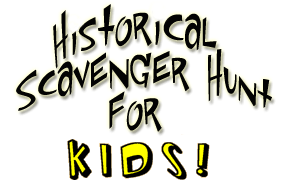

  |
|
|
A visit to the Scottsville Museum can enhance the education of students of all ages, from young children to lifelong learners. |
||||
An Historical Scavenger Hunt for Kids | ||||
 Want to get to know your town as an explorer? This activity is called 'letterboxing,' and it's a type of treasure hunt
started accidentally in Southern England in 1854. According to legend, a Victorian gentleman put his "business" card
in a bottle and hid it in a remote area of Dartmoor, England, to be found by curious visitors. The idea caught on, and
there are now reported to be over 10,000 letterboxes in Dartmoor.
Want to get to know your town as an explorer? This activity is called 'letterboxing,' and it's a type of treasure hunt
started accidentally in Southern England in 1854. According to legend, a Victorian gentleman put his "business" card
in a bottle and hid it in a remote area of Dartmoor, England, to be found by curious visitors. The idea caught on, and
there are now reported to be over 10,000 letterboxes in Dartmoor.
The idea came to the United States in 1998 when the Smithsonian Magazine published an article on the Dartmoor letterboxes. Letterboxes began to be placed in interesting places all over the U.S. They are hidden on public land in places that will not upset the natural features of the area. They are hidden well enough so that common passers-by will not pick up the box and walk off with it. Three letterboxes have been hidden in Scottsville for common letterboxing folk. For the Scottsville Museum's Historical Scavenger Hunt for Kids, an additional two boxes were added to the adventure, and the course was slightly rerouted. So what you now have created just for you, is an almost one mile long letterboxing hunt with FIVE different points! What You Will Need: A rubber stamp, an ink pad of any color, a writing utensil, a map of Scottsville found in the "Scottsville on the James" pamphlets that are all over town (check any local store on Valley Street), a print-out of the clues below, and a chaperon! What You Do: With all of the things listed above, go to the starting point designated on your Clues List. When you find a box, try not to let non-letterboxers know what you are doing. Carefully remove the box from its location, open it up, stamp your stamp into the box's Guest book (small notepad), and then use the box's stamp to stamp your personal Log Book. You may leave a message in the Guest book next to your stamp as well. When you are finished, carefully put everything back in the box, gather up your own materials, and rehide the box exactly the way you found it, in order that other explorers may come after you and record their discoveries. Are You Ready? Any additional questions concerning the art of letterboxing can be answered by going to the official letterboxing web site at http://letterboxing.org. Their web site will give you more clues for letterboxes hiding all over the United States, as well as teach you how to make your very own rubber stamp! The Clues: For a complete list of clues for the five letterboxes in Scottsville Museum's Historical Scavenger Hunt for Kids, visit Clues. |
||||
Virginia Standards of Learning | ||||
|
Exhibits at the museum can help to guide students according to the Virginia Standards of Learning. The museum provides educational experiences that support several of the history and social science SOLs: |
||||
| Kindergarten | Grade 5 | |||
| Grade 1 | Grade 6 | |||
| Grade 2 | Grade 9 | |||
| Grade 3 | Grade 10 | |||
| Grade 4 | Grade 11 | |||
Group Tours | ||||
Tours are available for school groups, Scout troops, clubs, and other organizations. For additional information, please contact the Museum at info@scottsvillemuseum.com or call 434-286-2247. |
||||
Recommended Classroom Activities | ||||
|
Teachers and other educators can adapt these ideas to use in conjunction with visits to the Scottsville Museum: Timeless TreasuresStudents choose one of the six families in this new exhibit and explore photographs and artifacts related to that family at the turn of the 20th Century. Upon return to the classroom, students design an exhibit to depict their chosen topic at the turn of the 21st Century and describe items that they would want to include in such an exhibit. Finally they design a third exhibit to describe the changes that they predict will occur by the turn of the 22nd Century. The James River through the ages Impact of technology The influence of geography on our community Comparison of childhood, past and present |
||||
| Home Exhibits About Visiting News Our History Archive Education Contact Your help Search |